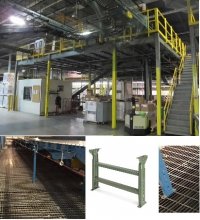CaiusFlint
REGISTERED
Hello all,
New to the forum and wanted to get input or direction on basic anchoring requirements when putting equipment (especially belt conveyors) and/or other structures up on large freestanding mezzanines.
The floors are all metal grate. But as it stands now- all the equipment put up on this level has been fixed in place with only simple tack-welds on the feet of the conveyor stands to the grating below. Seems like it might be lacking.
If anyone can point me to any sort of building code requirements for anchoring equipment on mezzanines, it would be greatly appreciated.
Thanks,
Flint
New to the forum and wanted to get input or direction on basic anchoring requirements when putting equipment (especially belt conveyors) and/or other structures up on large freestanding mezzanines.
The floors are all metal grate. But as it stands now- all the equipment put up on this level has been fixed in place with only simple tack-welds on the feet of the conveyor stands to the grating below. Seems like it might be lacking.
If anyone can point me to any sort of building code requirements for anchoring equipment on mezzanines, it would be greatly appreciated.
Thanks,
Flint

